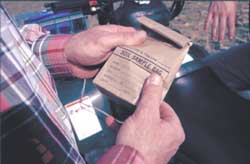
To be sensitive to the rising costs of fertilizers, it is a wise choice
to test your soil in the spring before adding any kind of fertilizer. This
will ensure that you only add what your soil truly needs, while avoiding
paying for chemicals that are not necessary. There are of course several
steps to testing soil successfully, and first and foremost you will need
to divide the pasture into sections. If possible work with a stainless
steel sampling probe to take up about 15 cores per area, but if you do not
have the tool, your spade will do just fine. Using clean plastic buckets,
place the samples into the containers. The goal is to get a good
understanding of the average pasture area, thus you will want to avoid
taking soil samples from areas that have burned, are ditches, or any other
areas that are contained. Separate samples should be collected from areas
where you have previously treated the grass differently or those patches
of the pasture where the grass is responding differently to treatment.
Keep in mind that if the area you are considering for fertilization is
already host to growing grasses, you will only need to sample soil about
four inches deep, while a barren area where you wish to seed or establish
grasses, needs to be sampled to a depth of eight inches. It is noteworthy
that the sample areas should be no larger than 15 acres. Additionally,
make sure you wait until the soil is not saturated with water since this
can influence the findings and also make treatment of the areas difficult.
Obviously you will want to make sure you properly identify each sample
after you mix it, and if you want special attention to be paid to a sample
from a problem area, indicate this on the labels as well.

|